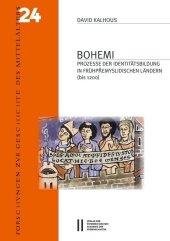 Neuerscheinungen 2018Stand: 2020-02-01 |
Schnellsuche
ISBN/Stichwort/Autor
|
Herderstraße 10
10625 Berlin
Tel.: 030 315 714 16
Fax 030 315 714 14
info@buchspektrum.de |

Forschungsstelle für Geschicht, David Kalhous
(Beteiligte)
Bohemi
Prozesse der Identitätsbildung in frühpremyslidischen Ländern (bis 1200)
Herausgegeben von Forschungsstelle für Geschichte des Mittelalters
2018. 261 S. 29 cm
Verlag/Jahr: VERLAG DER ÖSTERREICH. AKADEMIE DER WISSENSCHAFTEN 2018
ISBN: 3-7001-8210-4 (3700182104)
Neue ISBN: 978-3-7001-8210-8 (9783700182108)
Preis und Lieferzeit: Bitte klicken
Processes of identification were mostly studied on "barbarians" of late antique and early medieval post-Roman Europe. This book focuses on the polity of medieval inhabitants of Czech lands and examines, if the methodology developed by a Viennese group of scholars is also usable on high medieval central Europe. It shortly introduces and contextualises the beginnings and functioning of the Premyslid principality in the Czech lands. An important layer of identification is an external image. Therefore, the image of that area and of its rulers and inhabitants, Bohemi, in medieval narratives written within the borders of Holy Roman Empire is analysed with the focus on its dynamics and main trends. This imagination of Bohemi is contextualized in each written source and compared with the image of Bohemi in the chronicles written in the Premyslid principality. Both levels of comparison make it possible to understand the communication between those groups of texts and their intended recipients. In the next chapter, the communication between the Premyslid principality and the Holy Roman Empire is analysed based on the St.-Wenceslas cult. This Premyslid prince ( 935) and soon patron saint of Bohemi and their principality became hero of seven legends until 1150. As he was also venerated outside the borders of the Premyslid principality, the analysis of concrete material evidence of his cult offers another insight into the communication channels between the Czech lands and the rest of Europe. It, too, enables to identify especially those regions which had stronger links to the Czech lands and which seemed to be a bridge between them and the Holy Roman Empire. Finally, because historiographical narratives may become a powerful catalyst of self-identification, the author scrutinizes the possible impact of written texts on Bohemian elites. Based on this analysis, three historiographical narratives are observed and their importance for the self-identification of these elites is evaluated.


